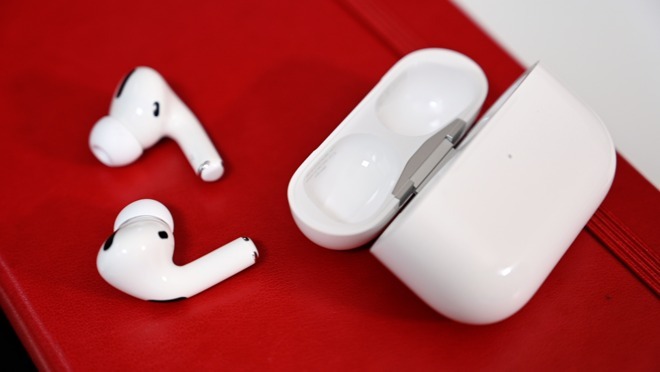A future version of AirPods could perform its ear detection using pressure built up within the ear canal, allowing it to be more selective on when it turns on and off and reducing the chance of accidental activation when placed on a table or another surface.

Apple's AirPods Pro
The AirPods and AirPods Pro have a feature where the audio accessories are able to detect whether or not they are being worn. By determining if they are in the user's ear, each AirPod can preserve battery by not activating or playing music when it isn't inserted, with the ability to know if only the left or right ear is inserted also allowing the host iPhone to know to only produce one stream to one device instead of two, again saving resources.
While the use of optical sensors and accelerometers are used in the AirPods to determine if they are individually being used, the technologies do still allow for false positives, such as by detecting motion similar to being worn, or by the optical sensors being obscured when placed in a pocket.
Some wireless earphones use the sudden rise of occlusion gain that is observed from a signal in the main speaker of the earphones when the unit is placed into the ear canal. Apple reasons this works, but has the drawback of requiring the creation of an air-tight seal by the ear tip, and a less-than-perfect seal can affect the low frequency response, again resulting in false positives.
Despite the success in the current form of AirPods, Apple believes it can improve upon the sensors using a different technique.
In a patent titled "Acoustic in ear detection for a hearable device" granted to Apple by the US Patent and Trademark Office on Tuesday, it is suggested the monitoring of air pressure could be used as a way to detect if the AirPods or another audio accessory are worn.
It is suggested the earphones can perform a confirmation they are worn before establishing an individual connection for each earbud to the host device over Bluetooth. To perform the check, the earphones use an air pressure sensor that is activated when the earbud is moved towards the ear canal.
An illustration of how the insertion of earbuds in the ear canal changes pressure by compression
During and after insertion, the air pressure sensor detects changes within the ear canal compared to ambient atmospheric pressure, namely the compression of air in the canal. On detecting a pulse from the air pressure signal caused through the insertion, the earbud can assume it needs to be activated.
At activation, a chime is used to tell the user it is switched on, as well as giving a few seconds for the connection to the host device to be established.
Apple reckons the pressure sensor is better, even in cases where there would be a pressure change when the earbuds are stored. "In the case of a user's pocket, there would be very little change in air volume, since air may travel freely through the pocket," the patent suggests.
The lack of a sound as used for the occlusion gain detection is also useful as it saves on battery power in comparison, while the detection of a spike in air pressure does not necessarily require a perfect air seal to be created in the first place, nor maintained.
Apple files numerous patent applications with the USPTO on a weekly basis, but while the existence of a filing does suggest areas of interest for Apple's research and development efforts, they do not necessarily guarantee the feature will make an appearance in a future product or service.
This is far from the only patent filing where Apple is trying to solve the problem of whether users are wearing earphones, along with the secondary problem of whether they are being worn correctly.
In October 2018, one patent application suggested the use of capacitive proximity sensors in over-the-ear headphones could sense the presence of a user's ear, and depending on which sensors are triggered by the ear's shape, to select the correct audio channel for that speaker. In November the same year, another application proposed doing the same thing using a microphone array and listening out for the user's voice.
An August 2019 patent application pairing suggested the use of detecting how earcups are pivoted to determine orientation, while the headband could include a sensor to change the power state when shifted from a flat to curved position.
The new patent credits Hongfeng Wang, Chen Na, and Ryan Moriyama as co-inventors. Wang is an embedded system engineer working on machine learning. Ryan Moriyama is an engineering manager working on key embedded technologies, who has previously worked for Beats on hardware development. Chen Na is an engineer on a team for core technology research and development.


